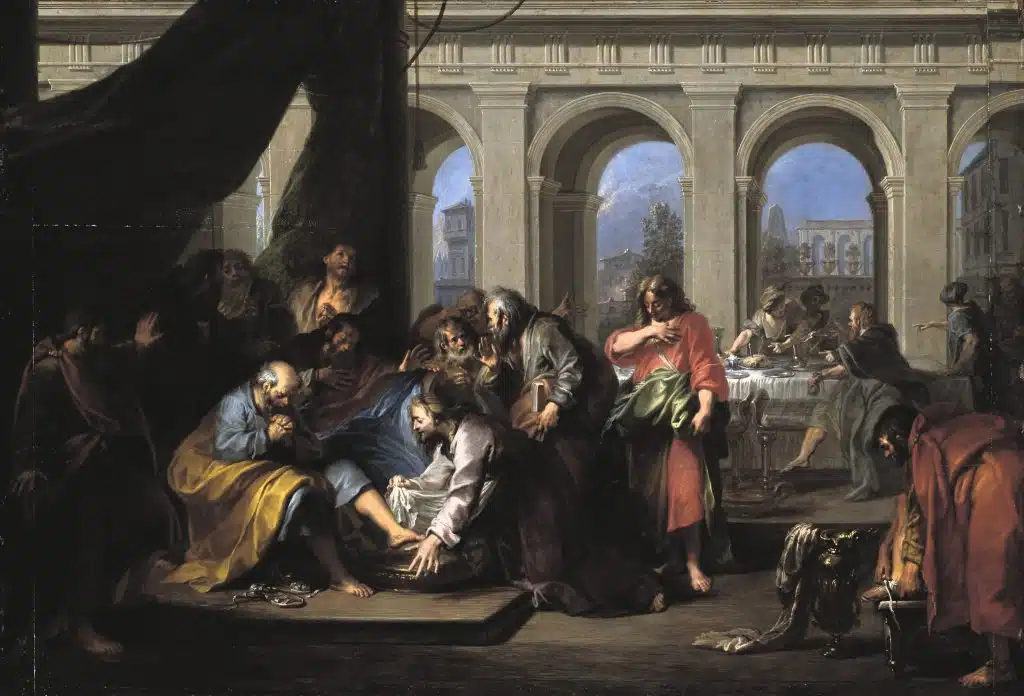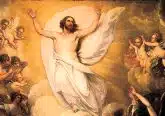Bertin and Humility

In a visually saturated world, it’s easy to feel overwhelmed and become desensitized to beauty. Visio Divina, Latin for “divine seeing,” encourages us to slow down and engage in visual contemplation, using art as a profound tool for connecting with the Divine.
A GUIDE TO VISIO DIVINA
Begin by making the sign of the cross and inviting the Holy Spirit to guide your contemplation. Spend a moment meditating on Christ Washing the Feet of His Disciples, ca. 1720-30 (late Baroque, early Rococo period) by Nicolas Bertin, located at The Art Institute of Chicago. Then, read John 13:1-20.
BACKGROUND
Foot-washing was an act of hospitality, as expressed in the Torah and expanded upon in the Jewish Talmud. During the time of Jesus (Anno Domini), it was customary for Jewish households to provide water for foot washing, as people walked in sandals. Washing was usually performed by a servant, occasionally by the guests themselves, but rarely by the host. Guests wouldn’t always wash their feet immediately upon entering a home, but typically did so before a meal.
Unlike the Synoptic Gospels, John’s Gospel does not explicitly describe the Passover meal or its timing, making the exact moment of the foot-washing unclear (see The Jerome Biblical Commentary, 450-451). While John states, “Before the feast of the Passover” (v.1) and later that Jesus “rose from supper” (v.4), Jewish tradition suggests it most likely took place before the meal of their Last Supper, which is how Bertin chose to depict this scene.
ENTER IN
As the sky fades to a deep blue, soft pink light cascades over the quiet world outside. Inside, servants scurry between the kitchen and dining table, setting plates and directing the preparations, ensuring everything is perfect for Jesus and His disciples’ Passover meal.
Before they settle in, Jesus rises and wraps Himself in a towel, signaling that everyone should clean up before they eat. But to everyone’s surprise, He kneels before the water basin, indicating His desire to wash the disciples’ feet. An outburst of shock ripples through the room. Bertin effortlessly captures the full range of emotions the disciples must have felt—from astonishment to confusion, fear and unworthiness.
Two gray-haired disciples next to Jesus gasp, exchanging a look of disbelief. One seems to whisper, “Is this really happening?” Behind them, another disciple pushes up his glasses, waving his hand in protest as if to say, “This is not right!” To the left, another disciple looks up to the heavens with hands clasped as if silently praying, “Why is my Lord and Master lowering Himself to do such a thing?”
Peter even exclaims, “You will never wash my feet!” (Jn. 13:8). Jesus responds to Peter and the confused disciples by saying this may not make sense now, but they will understand later. Jesus urges the disciples to allow Him to do this; otherwise, they can have no part in Him. Venerable Fulton Sheen explained that this “refusal to accept Divine cleansing is exclusion from intimacy with Him” (Life of Christ, 285).
Peter wrestles with this idea—“the idea of having no part with Our Lord humbled him unspeakably, as he committed not his feet, but his whole being to the Master” (Life of Christ, 285; Jn. 13:9). In Bertin’s painting, we see the exact moment Peter surrenders his fear and confusion, fully submitting to the Lord and accepting Jesus’ request. He closes his eyes and bows his head, implying that he believes he is unworthy.
Something interesting is happening in the background— there is commotion here, too. The servants remain focused on setting the table, seemingly unaware of the astonishing display between Jesus and His disciples. In a sense of urgency, a red-haired man flings himself over a bench to speak to the servant. He clutches a bag of coins in one hand and points with his other to the drama unfolding in the foreground. Though Scripture does not describe Judas Iscariot’s appearance, artists of the Middle Ages often depicted him with red hair as a way to distinguish him from the other disciples and symbolize his betrayal, as red hair was commonly associated with the devil. The servant meets Judas’ gaze while gesturing toward a loaf of bread pierced with a knife at its center. Bertin might be suggesting something deeper here—even the servant sees what Judas is about to do.
REFLECTION
Humility is a complex virtue. It is widely recognized as lowering oneself to serve another, as Jesus demonstrated in this act of love. However, Peter’s humility is often overlooked. True humility requires both the willingness to serve and the willingness to be served.
As we see with Peter, humility means embracing vulnerability in uncertainty and allowing others—especially Christ—to help us. Through foot- washing, Jesus teaches us that we cannot rely solely on ourselves. We cannot make ourselves clean; we must allow Him to cleanse us.
Peter’s initial reaction is deeply human and relatable. He doesn’t understand what’s happening or why, and Jesus will not offer an explanation. Confronted by the unknown, Peter responds emotionally—resisting, questioning and struggling to let go. Eventually, his love for Jesus leads him to surrender completely. Venerable Sheen further explores Peter’s reaction, noting that his reluctance to Jesus’ act of humility was rooted in his own pride, “ignoring his own need of inner redemption” (Life of Christ, 285).
Sometimes it is easier to serve others than to accept help ourselves. Through depicting Peter’s emotional struggle and his eventual beautiful surrender, Bertin shows us that humility isn’t just about giving, but also being able to accept and receive the grace that Jesus offers.
 Emma Cassani is the graphic designer behind The Catholic Telegraph. She is passionate about exploring the intersection between art and faith. | [email protected]
Emma Cassani is the graphic designer behind The Catholic Telegraph. She is passionate about exploring the intersection between art and faith. | [email protected]
This article appeared in the March 2025 edition of The Catholic Telegraph Magazine. For your complimentary subscription, click here.














